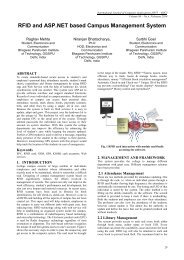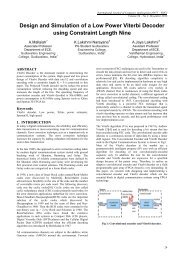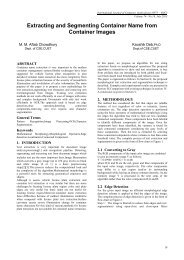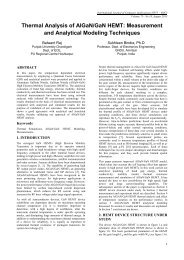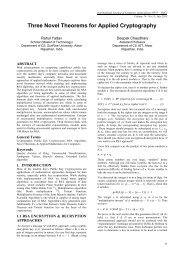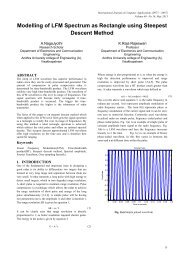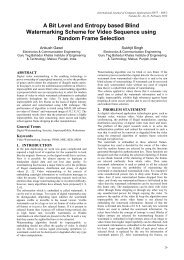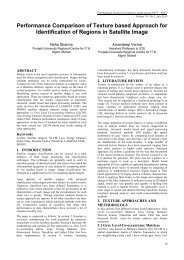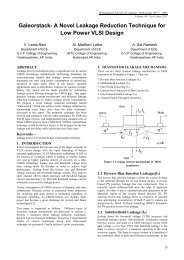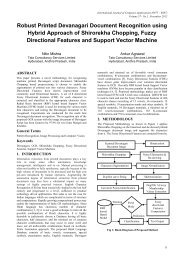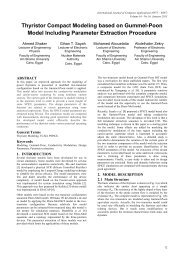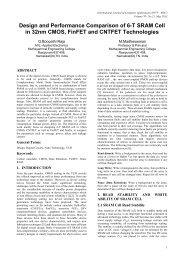Image Processing Based Systems and Techniques for the ...
Image Processing Based Systems and Techniques for the ...
Image Processing Based Systems and Techniques for the ...
You also want an ePaper? Increase the reach of your titles
YUMPU automatically turns print PDFs into web optimized ePapers that Google loves.
International Journal of Computer Applications (0975 – 888)<br />
Volume 47– No.10, June 2012<br />
<strong>Image</strong> <strong>Processing</strong> <strong>Based</strong> <strong>Systems</strong> <strong>and</strong> <strong>Techniques</strong> <strong>for</strong><br />
<strong>the</strong> Recognition of Ancient <strong>and</strong> Modern Coins<br />
Shatrughan Modi<br />
Frontier Research Group, Samsung India Software<br />
Operations,<br />
Bangalore- 560093, India<br />
ABSTRACT<br />
Coins are frequently used in everyday life at various places<br />
like in banks, grocery stores, supermarkets, automated<br />
weighing machines, vending machines etc. So, <strong>the</strong>re is a basic<br />
need to automate <strong>the</strong> counting <strong>and</strong> sorting of coins. For this<br />
machines need to recognize <strong>the</strong> coins very fast <strong>and</strong> accurately,<br />
as fur<strong>the</strong>r transaction processing depends on this recognition.<br />
Three types of systems are available in <strong>the</strong> market:<br />
Mechanical method based systems, Electromagnetic method<br />
based systems <strong>and</strong> <strong>Image</strong> processing based systems. This<br />
paper presents an overview of available systems <strong>and</strong><br />
techniques based on image processing to recognize ancient<br />
<strong>and</strong> modern coins.<br />
General Terms<br />
Neural Network, Pattern Recognition, <strong>Image</strong> <strong>Processing</strong>.<br />
Keywords<br />
Coin Recognition, <strong>Image</strong> <strong>Processing</strong>, Modern Coins, Ancient<br />
Coins<br />
1. INTRODUCTION<br />
There is a basic need of highly accurate <strong>and</strong> efficient<br />
automatic coin recognition systems in our daily life. Coin<br />
recognition systems <strong>and</strong> coin sorting machines have become a<br />
vital part of our life. They are used in banks, supermarkets,<br />
grocery stores, vending machines etc. In-spite of daily uses<br />
coin recognition systems can also be used <strong>for</strong> <strong>the</strong> research<br />
purpose by <strong>the</strong> institutes or organizations that deal with <strong>the</strong><br />
ancient coins. There are three types of coin recognition<br />
systems based on different methods used by <strong>the</strong>m available in<br />
<strong>the</strong> market:<br />
Mechanical method based systems<br />
Electromagnetic method based systems<br />
<strong>Image</strong> processing based systems<br />
The mechanical method based systems use parameters like<br />
diameter or radius, thickness, weight <strong>and</strong> magnetism of <strong>the</strong><br />
coin to differentiate between <strong>the</strong> coins. But <strong>the</strong>se parameters<br />
can not be used to differentiate between <strong>the</strong> different materials<br />
of <strong>the</strong> coins. It means if we provide two coins one original<br />
<strong>and</strong> o<strong>the</strong>r fake having same diameter, thickness, weight <strong>and</strong><br />
magnetism but with different materials to mechanical method<br />
based coin recognition system <strong>the</strong>n it will treat both <strong>the</strong> coins<br />
as original coin so <strong>the</strong>se systems can be fooled easily.<br />
The electromagnetic method based systems can differentiate<br />
between different materials because in <strong>the</strong>se systems <strong>the</strong> coins<br />
are passed through an oscillating coil at a certain frequency<br />
<strong>and</strong> different materials bring different changes in <strong>the</strong><br />
amplitude <strong>and</strong> direction of frequency. So <strong>the</strong>se changes <strong>and</strong><br />
<strong>the</strong> o<strong>the</strong>r parameters like diameter, thickness, weight <strong>and</strong><br />
Seema Bawa, PhD.<br />
Dept. of Computer Science <strong>and</strong> Engineering<br />
Thapar University<br />
Patiala-147004, India.<br />
magnetism can be used to differentiate between coins. The<br />
electromagnetic based coin recognition systems improve <strong>the</strong><br />
accuracy of recognition but still <strong>the</strong>y can be fooled by some<br />
game coins.<br />
In <strong>the</strong> recent years coin recognition systems based on images<br />
have also come into picture. In <strong>the</strong>se systems first of all <strong>the</strong><br />
image of <strong>the</strong> coin to be recognized is taken ei<strong>the</strong>r by camera<br />
or by some scanning. Then <strong>the</strong>se images are processed by<br />
using various techniques of image processing like FFT, DCT,<br />
edge detection, segmentation etc. <strong>and</strong> fur<strong>the</strong>r various features<br />
are extracted from <strong>the</strong> images. <strong>Based</strong> on <strong>the</strong>se features<br />
different coins are recognized. This paper presents existing<br />
systems <strong>and</strong> techniques proposed by various researchers on<br />
image based coin recognition.<br />
2. APPROACHES / TECHNIQUES<br />
There are various approaches proposed by various researchers<br />
<strong>for</strong> image based coin recognition. We can broadly classify<br />
<strong>the</strong>se approaches based on <strong>the</strong> coins (ancient coins, modern<br />
coins, ancient <strong>and</strong> modern both) on which <strong>the</strong>y can be applied.<br />
2.1 Approaches <strong>for</strong> Modern Coins<br />
Most of <strong>the</strong> approaches proposed till now can be applied <strong>for</strong><br />
recognition of modern coins.<br />
In 1992 [1] Minoru Fukumi et al. presented a<br />
rotational invariant neural pattern recognition system <strong>for</strong> coin<br />
recognition. They have used 500 yen coin <strong>and</strong> 500 won coin<br />
to per<strong>for</strong>m <strong>the</strong> experiment. In this work <strong>the</strong>y have created a<br />
multilayered neural network <strong>and</strong> a preprocessor consists of<br />
many slabs of neurons. This preprocessor was used to get a<br />
rotational invariant input <strong>for</strong> <strong>the</strong> multilayered neural network.<br />
For <strong>the</strong> weights of neurons in preprocessor, concept of<br />
circular array was used instead of square array. The results<br />
show that 25 slabs with 72 neurons in each slab give <strong>the</strong> best<br />
recognition.<br />
In 1993 [2] Minoru Fukumi et al. tried to achieve<br />
100% accuracy <strong>for</strong> coins. They have used 500 yen coin <strong>and</strong><br />
500 won coin. In this work <strong>the</strong>y have used Back Propagation<br />
(BP) <strong>and</strong> Genetic Algorithm (GA) to design neural network<br />
<strong>for</strong> coin recognition. BP is used to train <strong>the</strong> network. Then<br />
after training, GA is used to reduce <strong>the</strong> size of network by<br />
varying <strong>the</strong> architecture to achieve 100% recognition accuracy<br />
rate.<br />
Paul Davidsson [3] in 1996 presented an approach<br />
<strong>for</strong> coin classification using learning characteristic decision<br />
trees by controlling <strong>the</strong> degree of generalization. Decision<br />
trees constructed by ID3-like algorithms were unable to detect<br />
instances of categories not present in <strong>the</strong> set of training<br />
examples. Instead of being rejected, such instances get<br />
assigned to one of <strong>the</strong> classes actually present in <strong>the</strong> training<br />
set. To solve this problem <strong>the</strong> algorithm with learning<br />
characteristic, ra<strong>the</strong>r than discriminative, category<br />
1
descriptions was proposed. In addition, <strong>the</strong> ability to control<br />
<strong>the</strong> degree of generalization was identified as an essential<br />
property of such algorithms. Experiments were per<strong>for</strong>med on<br />
Canadian <strong>and</strong> Hong-Kong coins <strong>and</strong> accuracy of 99.7% <strong>for</strong><br />
Canadian <strong>and</strong> 98.3% <strong>for</strong> Hong-Kong coins was achieved.<br />
Michael Nolle et al. [4] at <strong>the</strong> ARC Seibersdorf<br />
research centre in 2003 developed a coin recognition <strong>and</strong><br />
sorting system called Dagobert. This system was designed <strong>for</strong><br />
fast classification of large number of modern coins from 30<br />
different countries. Coin classification was accomplished by<br />
correlating <strong>the</strong> edge image of <strong>the</strong> coin with a pre-selected<br />
subset of master coins <strong>and</strong> finding <strong>the</strong> master coin with lowest<br />
distance. Pre-selection of master coins was done based on<br />
three rotation-invariant features (edge angle distribution, edge<br />
distance distribution, occurrences of different rotationinvariant<br />
patterns on circles centered at edge pixels), coin<br />
diameter <strong>and</strong> thickness. Experiments on 12,949 coins were<br />
per<strong>for</strong>med <strong>and</strong> 99.24% recognition rate was achieved.<br />
A coin recognition system to recognize US coins<br />
using vector quantization <strong>and</strong> histogram modeling was<br />
presented by Seth McNeill et al. [5] in 2004. The system<br />
mainly focuses on <strong>the</strong> texture of various images imprinted on<br />
<strong>the</strong> coin tail. <strong>Based</strong> on different image texture <strong>the</strong> system<br />
differentiate between Bald eagle on <strong>the</strong> quarter, <strong>the</strong> Torch of<br />
liberty on <strong>the</strong> dime, Thomas Jefferson's house on <strong>the</strong> nickel,<br />
<strong>and</strong> <strong>the</strong> Lincoln Memorial on <strong>the</strong> penny. Experiments show<br />
that out of 200 coin images 188 were correctly classified.<br />
Thus, 94% recognition accuracy rate was achieved.<br />
In 2005 a multistage approach <strong>for</strong> coin classification<br />
using Eigenspace <strong>and</strong> Bayesian fusion was presented by<br />
Reinhold Huber et al. [6]. In <strong>the</strong> first stage, a translational <strong>and</strong><br />
rotational invariant description is computed. In a second stage,<br />
an illumination-invariant eigenspace is selected <strong>and</strong><br />
probabilities <strong>for</strong> coin classes are derived <strong>for</strong> both sides of each<br />
coin. In <strong>the</strong> final stage, coin class probabilities <strong>for</strong> both coin<br />
sides are combined through Bayesian fusion including a<br />
rejection mechanism. Experiments show that 93.23% of<br />
11,949 coins from thirty different countries were correctly<br />
classified.<br />
In 2005 [7] R. Bremananth et al. presented an<br />
approach using neural network <strong>for</strong> coin recognition. In this<br />
work <strong>the</strong>y have concentrated on <strong>the</strong> recognition of <strong>the</strong><br />
numerals on <strong>the</strong> coin ra<strong>the</strong>r than o<strong>the</strong>r images. For this <strong>the</strong>y<br />
extract a sub image of numeral from coin <strong>the</strong>n this sub image<br />
is used <strong>for</strong> character recognition. To achieve rotation<br />
invariance Gabor filters <strong>and</strong> Back Propagation neural network<br />
are used. Experiments are per<strong>for</strong>med on 1-rupee, 2-rupee <strong>and</strong><br />
5-rupee coin. The experiments show 92.43% recognition<br />
accuracy rate.<br />
L.J.P. van der Maaten et al. [8] in 2006 developed a<br />
fast system <strong>for</strong> reliable coin classification called COIN-O-<br />
MATIC. In this system coin classification is done based on<br />
edge-based statistical features (edge angle distributions, edge<br />
distance distributions, edge angle-distance distributions). The<br />
system consists of four subsystems: (1) a segmentation<br />
subsystem, (2) a feature extraction subsystem, (3) a<br />
classification subsystem, <strong>and</strong> (4) a verification subsystem.<br />
Experiments were per<strong>for</strong>med on MUSCLE-CIS dataset <strong>and</strong><br />
72% classification accuracy was achieved.<br />
Adnan Khashman et al. [9, 10] presented an<br />
Intelligent Coin Identification System (ICIS) in 2006. ICIS<br />
uses neural network <strong>and</strong> pattern averaging <strong>for</strong> recognizing<br />
rotated coins at various degrees. ICIS consists of two phases.<br />
First is image processing in which coin images are mode<br />
converted, cropped, compressed, trimmed, pattern averaged<br />
etc. This is <strong>the</strong> preprocessing phase. In second phase a back<br />
propagation neural network is trained. Once neural network<br />
International Journal of Computer Applications (0975 – 888)<br />
Volume 47– No.10, June 2012<br />
converges <strong>and</strong> learns <strong>the</strong>n only one <strong>for</strong>ward pass is used that<br />
yields <strong>the</strong> identification results. ICIS shows very encouraging<br />
results. It shows 96.3% correct identification i.e. 77 out of 80<br />
variably rotated coin images were correctly identified. ICIS is<br />
very effective in reducing time costs because it reduces <strong>the</strong><br />
processing data by preprocessing images.<br />
In 2006 [12] P.Thumwarin et al. presented a robust<br />
method <strong>for</strong> coin recognition with rotation invariance. In this<br />
method <strong>the</strong> rotation invariance feature is represented by <strong>the</strong><br />
absolute value of Fourier coefficients of polar image of coin<br />
on circles with different radii. In this paper <strong>the</strong> variations on<br />
surface of coin such as light reflection effect are also<br />
considered. These effects can be reduced by Fourier<br />
approximation of <strong>the</strong> coin image. Finally coins are recognized<br />
by calculating distance between <strong>the</strong> absolute value of Fourier<br />
coefficients obtained from <strong>the</strong> reference coin <strong>and</strong> <strong>the</strong> coin to<br />
be recognized.<br />
A fast <strong>and</strong> reliable coin recognition system based on<br />
registration approach was presented by Marco Reisert et al.<br />
[13] in 2007. For this gradient directions are used whereas<br />
gradient magnitude is completely neglected. Then<br />
classification is per<strong>for</strong>med by simple nearest neighbor<br />
classifier scheme followed by several rejection criteria to meet<br />
<strong>the</strong> dem<strong>and</strong> of low false positive rate. The system presented<br />
was also reliable to illumination <strong>and</strong> contrast changes.<br />
Experiments were per<strong>for</strong>med on CIS benchmark dataset.<br />
In 2009 [18] Linlin Shen et al. presented an image<br />
based approach <strong>for</strong> coin recognition. In this paper Gabor<br />
wavelets are used to extract features. Coin image is divided<br />
into number of small sections by concentric ring structures.<br />
Then Gabor coefficients from each section are concatenated to<br />
<strong>for</strong>m feature vectors. Then <strong>the</strong>se feature vectors are compared<br />
with <strong>the</strong> feature vectors of saved images in database.<br />
Identification is done using Euclidean distance <strong>and</strong> <strong>the</strong> nearest<br />
neighbor classifier. For experiments public MUSCLE<br />
database consisting of over 10,000 images is used. This<br />
algorithm shows <strong>the</strong> recognition accuracy rate of 74.27%.<br />
CHEN Cai-ming et al. [19] in 2010 presented a coin<br />
recognition system with rotation invariance. In this system<br />
same approach presented in [12] is used but with BP neural<br />
network i.e. <strong>the</strong> feature vector which is <strong>the</strong> input to BP neural<br />
network is obtained by calculating <strong>the</strong> absolute value of<br />
Fourier coefficients of polar image of coin on circles with<br />
different radii. The experiments show <strong>the</strong> accuracy rate of<br />
83%.<br />
An efficient method <strong>for</strong> coin recognition using a statistical<br />
approach was presented in 2010 by Hussein R. Al- Zoubi [20].<br />
In this paper statistical methods are used to recognize<br />
Jordanian coins. In this approach main focus is on area <strong>and</strong><br />
color of coins. First of all coin image is converted to gray<br />
level image <strong>the</strong>n <strong>the</strong> gray image is segmented into two regions<br />
coin <strong>and</strong> background based on <strong>the</strong> histogram of image. Then<br />
segmented image is cleaned <strong>and</strong> <strong>the</strong>n four parameters i.e. area,<br />
average red, average green <strong>and</strong> average blue are calculated.<br />
Then based on <strong>the</strong>se parameters decision is made that to<br />
which category <strong>the</strong> coin belongs. This approach yields high<br />
recognition rate of 97% which is very encouraging.<br />
In 2010 [21] Huahua Chen presented an approach<br />
<strong>for</strong> Chinese coin recognition based on unwrapped image <strong>and</strong><br />
rotation invariant template matching. In this approach first of<br />
all coin segmentation is done using Hough trans<strong>for</strong>m <strong>the</strong>n <strong>the</strong><br />
segmented image is unwrapped. Unwrapping is done by<br />
trans<strong>for</strong>ming reference <strong>and</strong> specimen coin image from<br />
Cartesian coordinates to polar coordinates. After unwrapping,<br />
<strong>the</strong> template matching is done <strong>and</strong> on <strong>the</strong> basis of this<br />
recognition is done. Experiments were per<strong>for</strong>med on 144<br />
variably rotated coins images. Out of which 116 were<br />
2
correctly recognized. So, overall 80.6% correct recognition<br />
was achieved.<br />
In 2011 [22] Vaibhav Gupta et al. presented an<br />
approach based on image subtraction technique <strong>for</strong><br />
recognition of Indian coins. In this approach system per<strong>for</strong>ms<br />
3 checks (radius, coarse <strong>and</strong> fine) on <strong>the</strong> input coin image.<br />
First of all radius is calculated of <strong>the</strong> input image. Then based<br />
on <strong>the</strong> radius a test image (rotated at certain fixed angle) from<br />
database is selected. Then coarse image subtraction between<br />
object <strong>and</strong> test image is done. Then, minima of <strong>the</strong> resultant<br />
image is checked if it is less than a specified threshold <strong>the</strong>n<br />
fine image subtraction between object <strong>and</strong> test image is done<br />
o<strong>the</strong>rwise new test image is selected. Then based on fine<br />
image subtraction, recognition takes place.<br />
2.2 Approaches <strong>for</strong> Ancient Coins<br />
There is very less work done on recognition of ancient coins.<br />
The main reason <strong>for</strong> this is that <strong>the</strong> ancient coins do not have<br />
symmetrical boundaries like modern coins because ancient<br />
coins were hammered or casted during manufacturing<br />
whereas modern coins are minted. Also ancient coins are<br />
generally found in poor conditions due to wear or fouling. So<br />
due to irregular shape <strong>and</strong> poor condition, <strong>the</strong> general<br />
approaches of coin recognition easily fail <strong>for</strong> ancient coins.<br />
Kaiping Wei et al. [14] in 2007 presented a novel<br />
approach <strong>for</strong> classification of ancient coins based on image<br />
textual in<strong>for</strong>mation. For extracting textual in<strong>for</strong>mation Tree-<br />
Structured Wavelet Trans<strong>for</strong>m (TWT) <strong>and</strong> Ant Colony<br />
Optimization (ACO) algorithm is used. The multi-resolution<br />
character of <strong>the</strong> texture is extracted by TWT, <strong>and</strong> in<strong>for</strong>mation<br />
can be accessed in various scale ra<strong>the</strong>r than low frequency. In<br />
addition, segmentation algorithm based on ACO is<br />
implemented be<strong>for</strong>e TWT to obtain textural in<strong>for</strong>mation with<br />
<strong>the</strong> absence of noise. The results show that this hybrid<br />
approach provides very accurate recognition results <strong>for</strong><br />
ancient coins.<br />
2.3 Approaches <strong>for</strong> both (Modern <strong>and</strong><br />
Ancient) Coins<br />
There are some approaches that can be applied to both ancient<br />
<strong>and</strong> modern coins.<br />
In 2006 [11] Laurens J.P. van der Maaten et al.<br />
presented algorithms <strong>for</strong> automatic coin classification. The<br />
algorithms take digital images of coins as input <strong>and</strong> generate a<br />
class as output i.e. to which class <strong>the</strong> coin belongs. There are<br />
two stages of automatic classification. First is feature<br />
extraction stage <strong>and</strong> second is classification stage. In first<br />
stage i.e. in feature extraction stage two types of features are<br />
extracted. First are Contour features <strong>and</strong> second are Texture<br />
features. For extracting Contour features first of all contour<br />
image is extracted from original image of coin <strong>and</strong> <strong>the</strong>n this<br />
contour image is represented in statistical features using<br />
multi-scale edge angle histograms <strong>and</strong> multi-scale edge<br />
distance histograms. For extracting texture features two types<br />
of wavelet features i.e. Gabor wavelet features <strong>and</strong><br />
Daubechies wavelet features are used. For experiments two<br />
datasets are used in this paper. The main dataset is <strong>the</strong><br />
MUSCLE CIS dataset, which is used <strong>for</strong> evaluating <strong>the</strong><br />
effectiveness of <strong>the</strong> feature types. The second dataset is <strong>the</strong><br />
Merovingen coin dataset which is employed to evaluate to<br />
what extent our feature types are appropriate <strong>for</strong> ancient coin<br />
classification. The results revealed that a combination of<br />
Contour <strong>and</strong> Texture features yield <strong>the</strong> best per<strong>for</strong>mance.<br />
Abdolah Chalechale [15] presented a novel<br />
approach <strong>for</strong> coin image recognition using image abstraction<br />
<strong>and</strong> spiral decomposition in 2007. The approach SDAI (Spiral<br />
International Journal of Computer Applications (0975 – 888)<br />
Volume 47– No.10, June 2012<br />
Decomposition of Abstract <strong>Image</strong>) enables measuring <strong>the</strong><br />
similarity between full color multi- component coin images<br />
<strong>and</strong> need no cost intensive image segmentation. Here an<br />
abstract image is derived from original image based on strong<br />
edges of <strong>the</strong> coin. Then spiral distribution of pixels in <strong>the</strong><br />
abstract image is employed as <strong>the</strong> key concept <strong>for</strong> feature<br />
extraction. Extracted features are scale, translation <strong>and</strong><br />
rotation invariant. The images used <strong>for</strong> query set <strong>and</strong> test<br />
database are scanned, photographed or collected from web.<br />
The proposed approach is compared with three o<strong>the</strong>r<br />
approaches i.e. QVE, PFD (Polar Fourier Descriptor) <strong>and</strong><br />
EHD (Edge Histogram Distribution). The results show that<br />
<strong>the</strong> proposed approach is much better than o<strong>the</strong>r three<br />
approaches because it shows significant improvement in recall<br />
ratio using proposed features.<br />
In 2007 [16, 17] Martin Kampel et al. gives <strong>the</strong><br />
overview <strong>and</strong> <strong>the</strong> preliminary results of EU project COINS<br />
(COmbatting Illicit Numismatic Sales). The project aims to<br />
substantially contribute to <strong>the</strong> fight against illegal trade <strong>and</strong><br />
<strong>the</strong>ft of coins which appears to be a major part of <strong>the</strong> illegal<br />
antiques market. In this paper recognition of both ancient <strong>and</strong><br />
modern coins is considered. They have also discussed <strong>the</strong><br />
existing approaches like Eigenspace approach, Contour based<br />
algorithms <strong>and</strong> Gradient based algorithms. They use two<br />
approaches <strong>for</strong> segmentation: Edge based segmentation <strong>and</strong><br />
Generalized Hough Trans<strong>for</strong>m (GHT). Then <strong>the</strong>y use edge<br />
based statistical distribution to extract <strong>the</strong> features. Then <strong>the</strong>y<br />
just compare <strong>the</strong> features to recognize <strong>the</strong> coin by using Knearest<br />
Neighbor algorithm. They have also compared <strong>the</strong><br />
results from both Edge based segmentation <strong>and</strong> GHT <strong>and</strong><br />
clearly <strong>the</strong> <strong>for</strong>mer per<strong>for</strong>med better than <strong>the</strong> later. Table 1<br />
presents a chronological summary of techniques developed<br />
<strong>for</strong> automatic recognition of ancient as well as modern coins.<br />
3. CONCLUSION<br />
This paper presents various systems developed <strong>and</strong> existing<br />
techniques <strong>for</strong> coin recognition based on image processing. A<br />
comparison of <strong>the</strong>se techniques has been given in Table 1.<br />
There are so many techniques proposed till now <strong>for</strong> modern<br />
coins, <strong>and</strong> maximum accuracy of 99.7% has been achieved in<br />
1996 <strong>for</strong> Canadian coins using decision trees, but still very<br />
less work has been done <strong>for</strong> <strong>the</strong> recognition of ancient coins.<br />
3
Sr.<br />
No.<br />
1 1992 [1]<br />
2 1993 [2]<br />
International Journal of Computer Applications (0975 – 888)<br />
Volume 47– No.10, June 2012<br />
Table 1. Chronological Development of <strong>Techniques</strong> <strong>for</strong> Modern <strong>and</strong> / or Ancient Coins<br />
Year Technique Used<br />
Neural network, circular<br />
array<br />
Neural network using Genetic<br />
Algorithm<br />
3 1996 [3] Decision trees<br />
4 2003 [4]<br />
5 2004 [5]<br />
6 2005 [6]<br />
7 2005 [7]<br />
8 2006 [8]<br />
9<br />
2006 [9,<br />
10]<br />
10 2006 [11]<br />
11 2006 [12]<br />
12 2007 [14]<br />
13 2007 [13]<br />
14 2007 [15]<br />
15<br />
2007 [16,<br />
17]<br />
16 2009 [18]<br />
17 2010 [19]<br />
Edge angle distribution, edge<br />
distance distribution<br />
Vector Quantization <strong>and</strong><br />
Histogram Modeling<br />
Eigenspaces <strong>and</strong> Bayesian<br />
fusion<br />
Neural network, Gabor filter,<br />
Statistical color threshold<br />
Edge angle distribution, edge<br />
distance distribution, edge<br />
angle-distance distribution<br />
Neural Network, Pattern<br />
Averaging<br />
Multi-scale edge angle<br />
histograms, Multi-scale edge<br />
distance histograms, Gabor<br />
wavelet, Daubechies wavelet<br />
Fourier approximation of<br />
polar image<br />
Tree structured wavelet<br />
trans<strong>for</strong>m, Ant colony<br />
optimization algorithm<br />
Registration approach based<br />
on gradient directions<br />
<strong>Image</strong> abstraction <strong>and</strong> spiral<br />
decomposition<br />
Edge based segmentation,<br />
Generalized hough trans<strong>for</strong>m<br />
<strong>and</strong> K-nearest neighbor<br />
algorithm<br />
Gabor wavelet, Euclidean<br />
distance <strong>and</strong> nearest neighbor<br />
classifier<br />
Fourier approximation of<br />
polar image, neural network<br />
Dataset of Coins<br />
Used<br />
500 yen (Japan)<br />
<strong>and</strong> 500 won<br />
(Korea) coin<br />
500 yen (Japan)<br />
<strong>and</strong> 500 won<br />
(Korea) coin<br />
Canadian <strong>and</strong><br />
Hong Kong coins<br />
Coins from 30<br />
countries<br />
Modern/Ancient Coins Accuracy<br />
Achieved<br />
Modern Ancient<br />
√<br />
√<br />
√<br />
99.7% -<br />
Canadian<br />
coins, 98.3% -<br />
Hong Kong<br />
coins<br />
√ 99.24%<br />
US coins √ 94%<br />
Coins from 30<br />
countries<br />
√ 93.23%<br />
Indian coins √ 92.43%<br />
MUSCLE CIS<br />
dataset<br />
Turkish 1 Lira<br />
<strong>and</strong> 2 Euro coin<br />
MUSCLE CIS<br />
dataset <strong>and</strong><br />
Merovingen coin<br />
dataset<br />
Thai amulet <strong>and</strong><br />
Thai baht coins<br />
CIS Benchmark<br />
dataset<br />
COIN BANK √ √<br />
MUSCLE CIS<br />
dataset<br />
√ 72%<br />
√ 96.3%<br />
√ √ 76%<br />
√<br />
√<br />
√<br />
√ √ 76%<br />
MUSCLE dataset √ 74.27%<br />
Chinese coins √ 83%<br />
18 2010 [20] Statistical approach Jordanian coins √ 97%<br />
19 2010 [21]<br />
Rotation invariant template<br />
matching<br />
20 2011 [22] <strong>Image</strong> subtraction technique Indian coins √<br />
Chinese coins √ 80.6%<br />
4
4. REFERENCES<br />
[1] Fukumi M. <strong>and</strong> Omatu S., "Rotation-Invariant Neural<br />
Pattern Recognition System with Application to Coin<br />
Recognition", IEEE Trans. Neural Networks, Vol.3, No.<br />
2, pp. 272-279, March, 1992<br />
[2] Fukumi M. <strong>and</strong> Omatu S., "Designing A Neural Network<br />
For Coin Recognition By A Genetic Algorithm",<br />
Proceedings of 1993 International Joint Conference on<br />
Neural Networks, 1993:2109-2112.<br />
[3] P. Davidsson, “Coin classification using a novel<br />
technique <strong>for</strong> learning characteristic decision trees by<br />
controlling <strong>the</strong> degree of generalization”, Ninth<br />
International Conference on Industrial & Engineering<br />
Applications of Artificial Intelligence & Expert <strong>Systems</strong>,<br />
1996.<br />
[4] M. Nolle, H. Penz, M. Rubik, K. Mayer, I. Holl<strong>and</strong>er <strong>and</strong><br />
R. Granec, “Dagobert – A New Coin Recognition <strong>and</strong><br />
Sorting System”, Proceedings of <strong>the</strong> 7th International<br />
Conference on Digital <strong>Image</strong> Computing - <strong>Techniques</strong><br />
<strong>and</strong> Applications (DICTA’03), Syndney, Australia.<br />
[5] McNeill S., Schipper J., Sellers T. <strong>and</strong> Nechyba M.C..<br />
“Coin Recognition using Vector Quantization <strong>and</strong><br />
Histogram Modeling”. 2004 Florida Conference on<br />
Recent Advances in Robotics (FCRAR)<br />
[6] Reinhold Huber, Herbert Ramoser, Konrad Mayer,<br />
Harald Penz, Michael Rubik, “Classification of coins<br />
using an eigenspace approach”, Pattern Recognition<br />
Letters (2005), Vol.26, No.1, 61-75<br />
[7] R. Bremananth, B. Balaji, M. Sankari <strong>and</strong> A. Chitra, “A<br />
new approach to coin recognition using neural pattern<br />
analysis” IEEE Indicon 2005 Conference, Chennai,<br />
India, 11 - 13 Dec. 2005.<br />
[8] L.J.P. van der Maaten, P.J. Boon, “COIN-O-MATIC: A<br />
fast system <strong>for</strong> reliable coin classification”, MUSCLE<br />
CIS Coin Recognition Competition Workshop 2006<br />
[9] Khashman A., Sekeroglu B. <strong>and</strong> Dimililer K.,<br />
“Intelligent Coin Identification System”, Proceedings of<br />
<strong>the</strong> IEEE International Symposium on Intelligent Control<br />
( ISIC'06 ), Munich, Germany, 4-6 October 2006.<br />
[10] Khashman A., Sekeroglu B. <strong>and</strong> Dimililer K., “ICIS: A<br />
Novel Coin Identification System”, Lecture Notes in<br />
Control <strong>and</strong> In<strong>for</strong>mation Sciences, Vol. 345, Springer-<br />
Verlag, September 2006.<br />
[11] L.J.P. van der Maaten <strong>and</strong> E.O. Postma, “Towards<br />
automatic coin classification”, Proceedings of <strong>the</strong> EVA-<br />
Vienna 2006, Vienna, Austria, 2006.<br />
International Journal of Computer Applications (0975 – 888)<br />
Volume 47– No.10, June 2012<br />
[12] Thumwarin, P., Malila, S., Janthawong, P. <strong>and</strong> Pibulwej,<br />
W., “A Robust Coin Recognition Method with Rotation<br />
Invariance”, 2006 International Conference on<br />
Communications, Circuits <strong>and</strong> <strong>Systems</strong> Proceedings,<br />
2006.<br />
[13] Reisert M., Ronneberger O. <strong>and</strong> Burkhardt H., “A Fast<br />
<strong>and</strong> Reliable Coin Recognition System”, in Proceedings<br />
of <strong>the</strong> 29th DAGM conference on Pattern recognition,<br />
2007<br />
[14] Kaiping Wei, Bin He, Fang Wang, Tao Zhang <strong>and</strong><br />
Quanjun Ding, "A Novel Method <strong>for</strong> Classification of<br />
Ancient Coins <strong>Based</strong> on <strong>Image</strong> Textures," dmamh,<br />
pp.63-66, Second Workshop on Digital Media <strong>and</strong> its<br />
Application in Museum & Heritage (DMAMH 2007),<br />
2007<br />
[15] Chalechale, A. “Coin Recognition Using <strong>Image</strong><br />
Abstraction And Spiral Decomposition”, 9th<br />
International Symposium on Signal <strong>Processing</strong> <strong>and</strong> Its<br />
Applications, 2007. ISSPA 2007.<br />
[16] Zaharieva, M., Kampel, M. <strong>and</strong> Zambanini, S., “<strong>Image</strong><br />
based recognition of coins – An Overview of <strong>the</strong> COINS<br />
project.”, 31st AAPR/OAGM Workshop, Krumbach,<br />
Austria, 2007.<br />
[17] Kampel, M. <strong>and</strong> Zambanini, S., “Optical Recognition of<br />
Modern <strong>and</strong> Roman Coins”, Layers of Perception- CAA<br />
2007.<br />
[18] Shen, L., Jia, S., Ji, Z. <strong>and</strong> Chen, W.S., “Statistics of<br />
Gabor features <strong>for</strong> coin recognition”, IEEE International<br />
Workshop on Imaging <strong>Systems</strong> <strong>and</strong> <strong>Techniques</strong>, 2009.<br />
[19] Cai-ming Chen, Shi-qing Zhang, Yue-fen Chen, "A Coin<br />
Recognition System with Rotation Invariance," 2010<br />
International Conference on Machine Vision <strong>and</strong><br />
Human-machine Interface, 2010<br />
[20] Al-Zoubi, H.R., “Efficient coin recognition using a<br />
statistical approach”, 2010 IEEE International<br />
Conference on Electro/In<strong>for</strong>mation Technology (EIT),<br />
2010.<br />
[21] Chen, H. “Chinese Coin Recognition <strong>Based</strong> on<br />
Unwrapped <strong>Image</strong> <strong>and</strong> Rotation Invariant Template<br />
Matching”, Third International Conference on Intelligent<br />
Networks <strong>and</strong> Intelligent <strong>Systems</strong>, 2010.<br />
[22] Gupta, V., Puri, R., Verma, M., “Prompt Indian Coin<br />
Recognition with Rotation Invariance using <strong>Image</strong><br />
Subtraction Technique”, International Conference on<br />
Devices <strong>and</strong> Communications (ICDeCom), 2011.<br />
5



